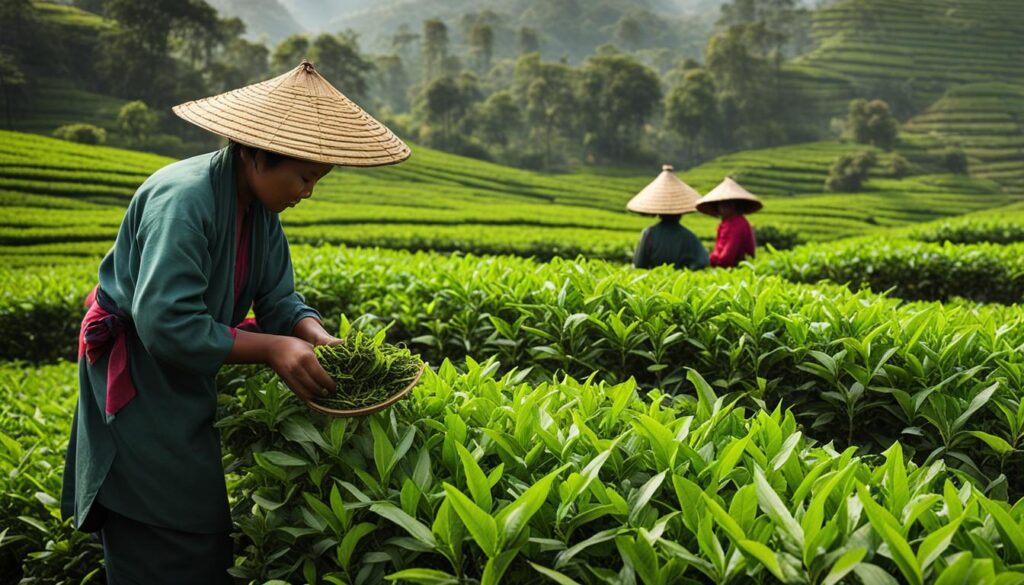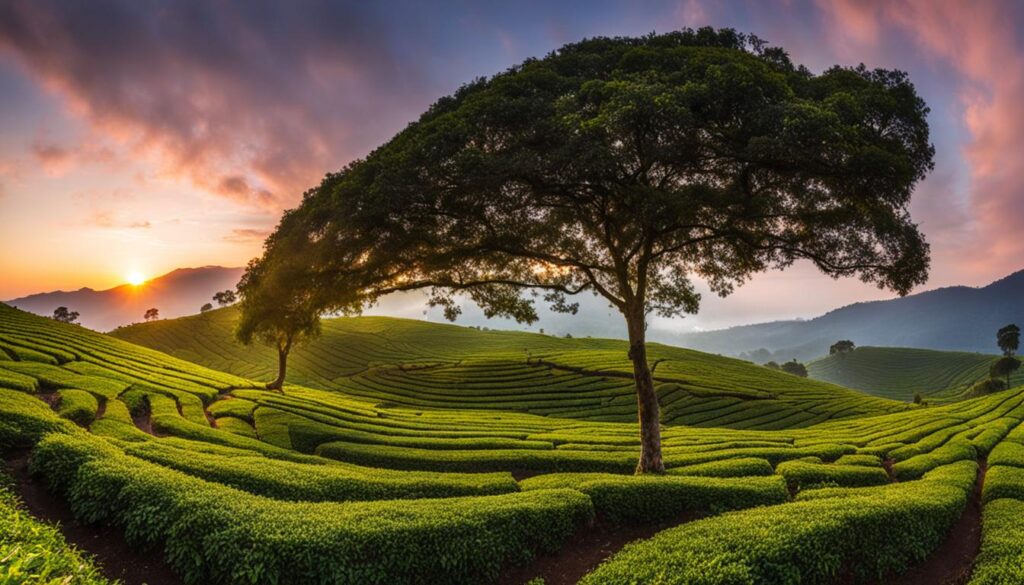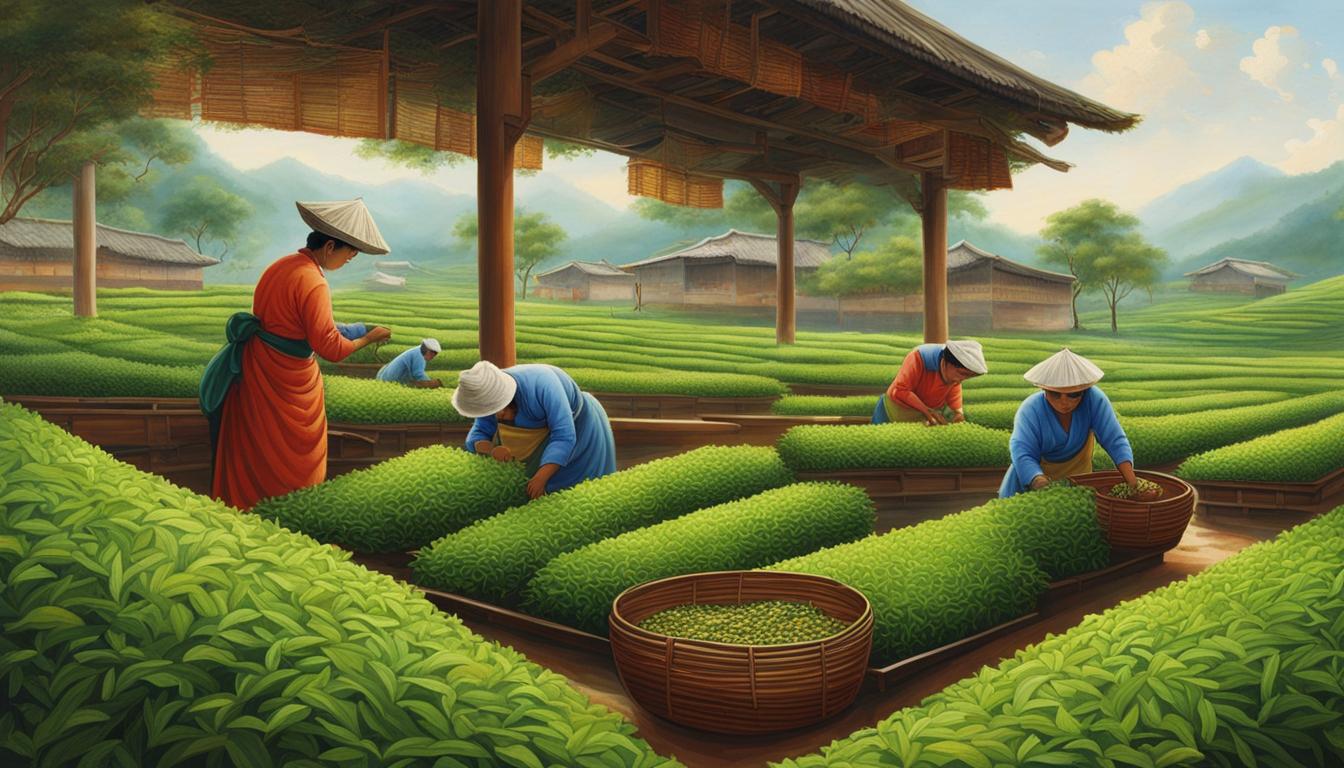Welcome to our exciting journey into the fascinating world of tea processing! In this article, we will delve into the intricacies of tea production, taking you behind the scenes to tea estates and factories where the magic happens. Get ready to uncover the secrets of tea processing and gain valuable insights that will enhance your tea appreciation and knowledge.
Key Takeaways:
- Tea processing involves different methods based on the level of oxidation.
- Black tea and green tea are the most widely consumed types globally.
- Tea gardens play a crucial role in ensuring the quality and flavor of tea.
- A tea manufacturing process tour offers a behind-the-scenes look at the entire tea production process.
- Tea brewing parameters vary for each type of tea, unlocking its full flavor potential.
Join us as we explore the world of tea processing, where tradition meets innovation, and discover why estate visits and tea tourism are invaluable experiences for tea enthusiasts. Get ready to unlock a world of tea processing insights and embark on a tea journey like no other!
The Importance of Tea Gardens in Tea Production
Tea gardens are the heart and soul of tea production. They provide the perfect environment for growing the Camellia sinensis plants and play a crucial role in ensuring the quality and flavor of the tea. With their meticulous cultivation and harvesting techniques, tea farms produce the finest tea leaves for further processing.
Each tea estate has its own unique processing methods to transform the freshly harvested leaves into various types of tea. The journey from plucking to final product involves a series of carefully orchestrated steps, including withering, rolling, oxidation, drying, and sorting. These steps contribute to the distinct characteristics of each tea, defining its flavor, color, and aroma.
Understanding the importance of tea gardens and the processing methods used in tea production allows us to appreciate the craftmanship that goes into every cup of tea. By experiencing tea leaf processing first-hand, we gain a deeper understanding of the journey from farm to cup, and we can truly savor the unique flavors that come from the careful cultivation and processing of tea leaves.
Table: Tea Farm Production Techniques
| Technique | Description |
|---|---|
| Leaf Plucking | The leaves are carefully plucked at the optimal stage of maturity to ensure the best flavor and aroma. |
| Withering | The freshly plucked leaves are spread out to remove excess moisture, making them more pliable for rolling. |
| Rolling | The withered leaves are rolled, breaking their cell walls and releasing enzymes that initiate oxidation. |
| Oxidation | The rolled leaves are left to oxidize, where chemical reactions occur, resulting in the characteristic flavors of the tea. |
| Drying | The oxidized leaves are dried to stop the oxidation process and remove any remaining moisture. |
| Sorting | The dried leaves are sorted based on size and quality, ensuring only the best leaves make it into the final product. |
Tea gardens and their production techniques are the foundation of exceptional teas. Through tea farm visits and learning about tea estate processing methods, we gain a deeper appreciation for the artistry and science behind tea production, enhancing our enjoyment of this ancient and beloved beverage.
Exploring the Tea Manufacturing Process
A tea manufacturing process tour offers a behind-the-scenes look at how tea is processed from the freshly plucked leaves to the final product. During the tour, visitors can learn about the different stages of tea production, including withering, rolling, oxidation, drying, and sorting. They can witness the various machinery and equipment used in the tea manufacturing process and gain insights into the techniques and skills required to produce high-quality teas. This immersive experience allows participants to appreciate the craftsmanship and attention to detail involved in tea processing.

Tea manufacturing process tours provide a unique opportunity to delve into the fascinating world of tea. From withering to sorting, visitors can witness firsthand how each step contributes to the final product’s flavor, aroma, and appearance. It’s a truly eye-opening experience for tea enthusiasts and anyone curious about the art and science of tea production.
Explore tea garden processing insights and witness the intricate tea manufacturing process on educational tours. These tours offer a comprehensive understanding of the methods employed to transform tea leaves into the diverse range of teas we enjoy. Participants can engage with knowledgeable guides, who provide valuable insights and answer any questions along the way. Whether it’s observing the withering process or witnessing the final sorting of tea leaves, these tours offer an intimate look at the techniques and craftsmanship behind the world’s favorite beverage.
By participating in tea manufacturing process tours, tea enthusiasts can gain a deeper appreciation for the skill and expertise required to produce high-quality teas. The tours also provide an opportunity to connect with fellow tea lovers, share experiences, and expand one’s knowledge of the rich history and cultural significance of tea. Whether you’re a tea connoisseur or simply curious about the tea-making process, these educational tours offer a captivating and educational experience.
Unveiling the Secrets of Tea Brewing
Tea brewing is an essential part of the tea processing journey. Each type of tea requires specific brewing parameters, including water temperature, steeping time, and tea-to-water ratio, to unlock its full flavor potential. Tea enthusiasts can participate in tea leaf to cup experiences, where they learn how to brew tea correctly and explore different brewing techniques such as gongfu style or Western style. These experiences provide a deeper understanding of the sensory aspects of tea, including aroma, taste, and mouthfeel. Participants can discover the nuances and complexities of different teas and develop their own preferences for brewing methods.

The Essential Elements of Tea Brewing
When it comes to tea brewing, several key elements need to be considered to ensure a perfect cup of tea:
- Water Temperature: Different types of tea require specific water temperatures to achieve the optimal flavor. Green teas generally benefit from lower temperatures around 170-180°F (77-82°C), while black teas may be brewed at higher temperatures around 200-212°F (93-100°C).
- Steeping Time: The steeping time determines the strength and character of the tea. For delicate teas like white tea or green tea, shorter steeping times of 1-3 minutes are recommended. Black teas and oolong teas can be steeped for 3-5 minutes or longer to extract their full flavor.
- Tea-to-Water Ratio: Finding the right balance between tea leaves and water is crucial for a flavorful cup. As a general guideline, use 1 teaspoon of loose tea leaves or 1 tea bag per 8 ounces (240 ml) of water.
“The art of brewing tea lies in the ability to bring out the best characteristics of the tea leaves. It’s a delicate balance between temperature, time, and technique.”
Exploring Brewing Techniques
Tea brewing techniques provide different ways to unleash the flavors and aromas of tea. Here are two popular brewing techniques:
- Gongfu Style: This Chinese tea brewing method involves using a small teapot and multiple short infusions. It allows for a more controlled extraction of the tea’s flavors and requires careful attention to water temperature, steeping time, and the number of infusions.
- Western Style: This brewing method is commonly used in Western countries and involves steeping tea in a larger teapot or mug. It typically requires longer steeping times and larger tea-to-water ratios compared to gongfu style.
By exploring different brewing techniques, tea enthusiasts can discover new dimensions of their favorite teas and appreciate the versatility and complexity of tea leaves.
Tea Tourism: Immersive Experiences for Tea Enthusiasts
Tea tourism is a wonderful opportunity for tea enthusiasts to go beyond their teacups and dive into the fascinating world of tea production. It offers a unique and immersive experience, allowing participants to witness the entire tea processing journey, from the tea gardens to the tea factories. These behind-the-scenes tea production insights provide a deeper understanding of the craftsmanship and attention to detail involved in creating the teas we love.
One of the most exciting aspects of tea tourism is the chance to go on tea processing factory tours. These tours take visitors into the heart of the tea industry, where they can observe the various steps involved in transforming tea leaves into the final product. From withering and rolling to oxidation, drying, and sorting, participants can see firsthand the intricate processes that contribute to the flavor, aroma, and appearance of different types of tea.
Tea production educational tours are another highlight of tea tourism. These tours offer a comprehensive learning experience, providing participants with valuable insights into the techniques and skills required to produce high-quality teas. Guided by tea experts, attendees can delve into topics such as tea leaf processing, tea tasting, and brewing methods. Through interactive workshops and demonstrations, they can develop a deeper appreciation for the nuances of tea and gain practical knowledge to enhance their own tea brewing skills.
Table: Tea Tourism Activities
| Activities | Description |
|---|---|
| Tea Garden Visits | Explore lush tea gardens and learn about the cultivation and harvesting techniques used to produce high-quality tea leaves. |
| Tea Factory Tours | Take a guided tour of tea factories to witness the tea processing methods, machinery, and equipment in action. |
| Tea Tasting Sessions | Participate in tea tastings led by tea experts and discover the diverse flavors and profiles of different teas. |
| Workshops and Demonstrations | Engage in hands-on workshops and demonstrations to learn about tea brewing techniques and tea leaf processing. |
| Cultural Experiences | Immerse yourself in the local tea-growing communities, experience their traditions, cuisines, and learn about their unique tea cultures. |
Tea tourism not only offers tea enthusiasts the opportunity to deepen their knowledge and understanding of tea but also allows them to connect with tea-growing regions and support sustainable tea practices. It fosters a sense of appreciation for the hard work and dedication of tea growers and producers. So, if you’re a tea lover looking to embark on a truly immersive tea adventure, tea tourism is definitely the way to go!
Conclusion
Gaining insights into the world of tea processing is a fascinating journey that can be embarked upon through estate visits and tea tourism. By exploring tea gardens, estates, and factories, tea enthusiasts can delve into the behind-the-scenes aspects of tea production and uncover the secrets of tea processing. These immersive experiences offer a unique opportunity to learn about the different types of tea, the techniques used in tea leaf processing, and the factors that contribute to the quality and flavor of teas.
Understanding tea processing not only enhances our appreciation of this ancient beverage but also allows us to optimize the enjoyment of every cup. By learning about the various tea processing methods and brewing techniques, we can unlock the full flavor potential of different tea types. From black tea to green tea, oolong to white tea, gaining tea processing insights empowers us to make informed choices and explore the nuances and complexities of each tea.
Engaging in tea tourism not only provides us with a direct connection to the tea-growing communities but also promotes sustainable tea practices. By immersing ourselves in the local traditions, cuisines, and cultures surrounding tea production, we not only deepen our knowledge but also support the preservation of this rich cultural heritage. Tea tourism offers a platform for tea lovers to celebrate and contribute to the world of tea, ensuring its legacy for future generations.
FAQ
What is tea processing?
Tea processing involves using Camellia sinensis leaves and leaf buds to produce different types of tea, including green, white, yellow, oolong, and black tea. The processing methods vary based on the extent of oxidation, which gives rise to the different types of tea.
Which countries are the major producers of tea?
India and China are the major producing countries of tea globally, with black tea and green tea being the most consumed types.
What is specialty tea?
Specialty tea refers to high-grade, organic, and hand-crafted teas that are gaining popularity among tea enthusiasts.
Are European countries producing their own teas?
Yes, European countries are experimenting with growing and producing their own teas.
What can tea growers optimize by understanding tea processing methods?
Tea growers can optimize the quality and health benefits of their teas by understanding the processing methods and variations in tea types.





